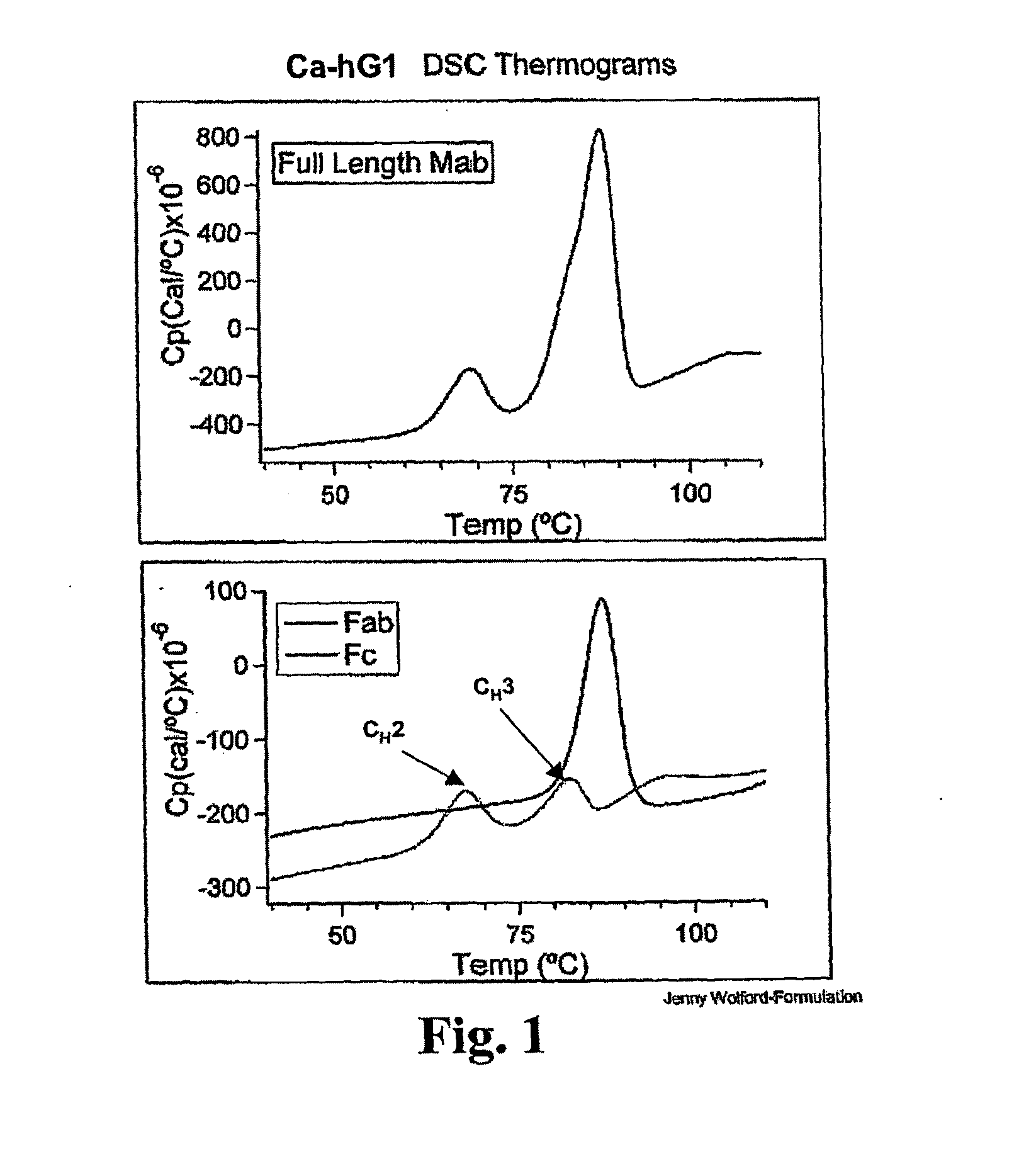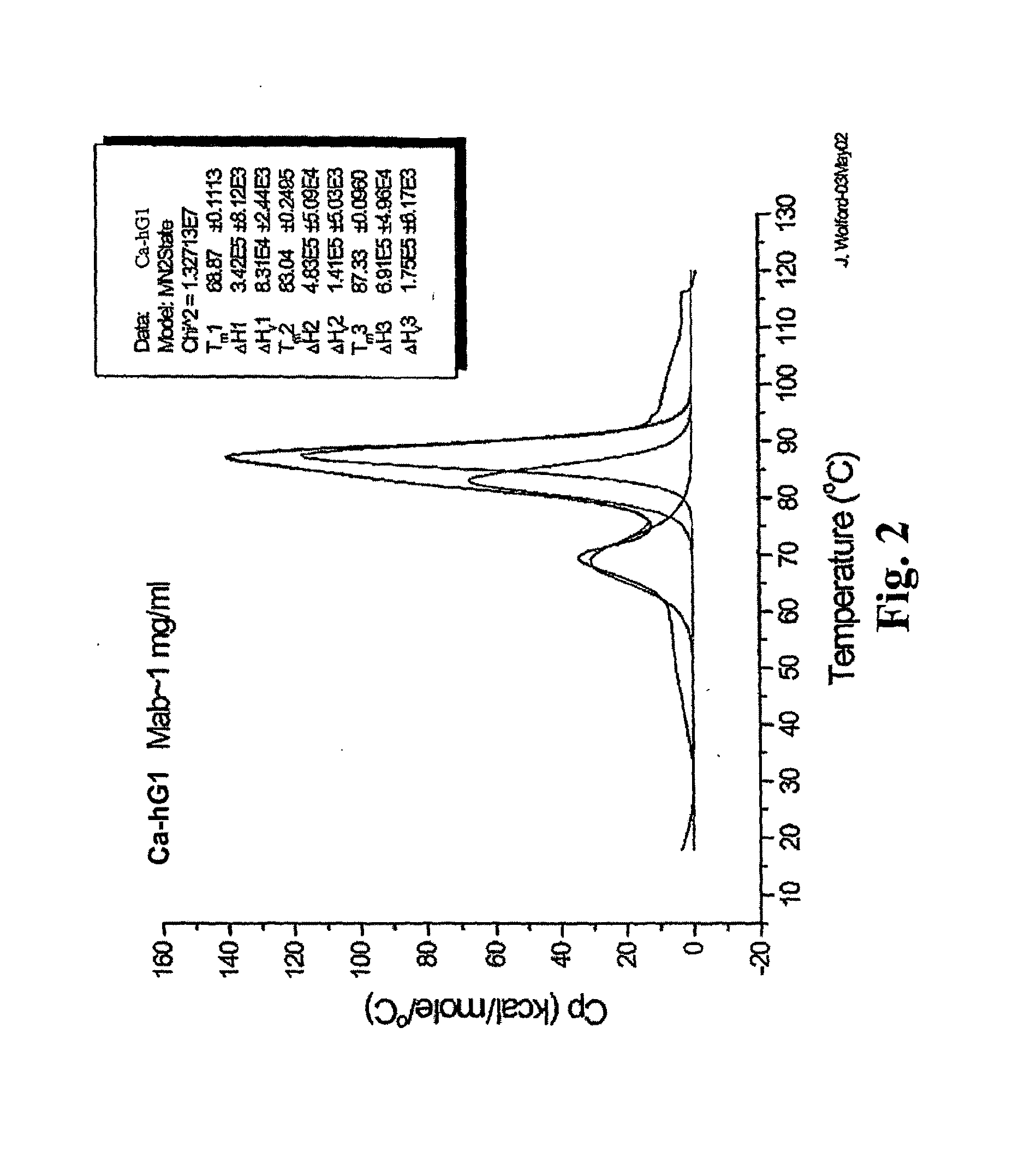Integrated approach for generating multidomain protein therapeutics
a multi-domain protein and integrated approach technology, applied in the field of therapeutic protein development, can solve the problems of short shelf life of high concentration liquid formulations, insufficient solubility of proteins with desired therapeutic properties, and loss of biological activity, so as to improve improve the effect of overall drug development efficiency, and improve the overall therapeutic
- Summary
- Abstract
- Description
- Claims
- Application Information
AI Technical Summary
Benefits of technology
Problems solved by technology
Method used
Image
Examples
example 1
6.1. Example 1
Contribution of Fab and Fc Domains to Tm Values and Stability
[0258]The Fab and Fc fragments of Ca-hG1 and Ba-hG1 were generated in order to learn more about the properties of the antibody Components. One long-term goal in studies of intact Mabs and their fragments is to understand the relationship between stability and structure. Currently it is known that Ca-hG1 is more stable with respect to aggregation when compared to Ba-hG1. This stability is further confirmed using the battery of analytical stability indicating assays. This stability difference offers an opportunity to compare properties of each antibody and to determine if there are measurable differences that can be exploited to understand the stability of these specific Mabs and more broadly applied to additional antibodies.
[0259]Fab and Fc domains were generated from full Mabs Ca-hG1 and Ba-hG1 using papain. A commercial kit from Pierce (Immunopure Fab Preparation Kit Pierce product #44885: Immunopure IgG Bin...
example 2
6.2. Example 2
Examination of the Contribution of the Variable Domain to Tm and pI Values
[0266]Fab fragments from 6 individual antibodies, several of which recognize the same epitope (Ca-hG1, Ca1-hG1 and Ca1-hG1a) were isolated. The Tm and pI for each was determined. The Fab fragments from Ca-hG1 and Ca1-hG1 differ by only about 13 amino acids, while Ca1-hG1 and Ca1-hG1a differ by only 3 amino acids. These three highly related molecules show only small differences in their pI and Tm values. In contrast, the completely unrelated molecules, Aa-hG1, Ba-hG1 and Da-hG1, show very different profiles (FIG. 17).
[0267]To examine the contribution of the Fab region to Tm and pI values in the context of a full length antibody, 18 individual Fab clones isolated from a single phage display library were converted into full length IgG1 and purified from transient transfections. These molecules differ only in their variable regions. The subsequent analysis of these clones demonstrate that they have a...
example 3
6.3. Example 3
Examination of the Contribution of the Fc Hinge Region to Tm and pI Values
[0273]A number of different mutations were generated in the hinge region of the antibody Fa6-hG1. The Tm of the Fab domain of the parental antibody and each hinge mutant was determined by DSC analysis of the intact antibodies (FIG. 20). In addition, the pI values of the parent and several of the mutants were determined (FIG. 20). Note that for the hinge variants for which a pI was determined, the amino acid changes made did not alter the net charge based on amino acid sequence and as expected has little effect on the pI. In addition, the Tm values for these closely related molecules are nearly identical indicating that the sequence of hinge has little influence on the Tm of the Fab.
PUM
| Property | Measurement | Unit |
|---|---|---|
| Tm | aaaaa | aaaaa |
| temperature | aaaaa | aaaaa |
| concentration | aaaaa | aaaaa |
Abstract
Description
Claims
Application Information
 Login to View More
Login to View More - R&D
- Intellectual Property
- Life Sciences
- Materials
- Tech Scout
- Unparalleled Data Quality
- Higher Quality Content
- 60% Fewer Hallucinations
Browse by: Latest US Patents, China's latest patents, Technical Efficacy Thesaurus, Application Domain, Technology Topic, Popular Technical Reports.
© 2025 PatSnap. All rights reserved.Legal|Privacy policy|Modern Slavery Act Transparency Statement|Sitemap|About US| Contact US: help@patsnap.com



